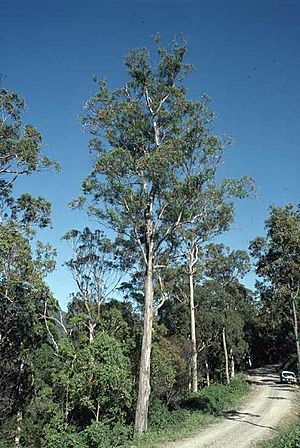Large-fruited grey gum facts for kids
Quick facts for kids Large-fruited grey gum |
|
|---|---|
 |
|
| Scientific classification | |
| Genus: |
Eucalyptus
|
| Species: |
canaliculata
|
| Synonyms | |
|
|
The Large-fruited Grey Gum (scientific name: Eucalyptus canaliculata) is a special type of gum tree. It's only found in a small part of New South Wales, Australia. This tree is known for its smooth, mostly grey bark. It has long, curved leaves, and its flowers are white, growing in groups of seven. After the flowers, it produces fruit that looks like a cone or a half-sphere.
Contents
What Does the Large-fruited Grey Gum Look Like?
The Large-fruited Grey Gum is a tall tree. It can grow up to 30 metres (98 ft) high, which is about as tall as a 10-story building! This tree has a special woody swelling at its base called a lignotuber. This helps the tree regrow if it gets damaged, for example, by a bushfire.
Bark and Leaves
The bark of this gum tree is mostly smooth and grey. As the tree gets older, the bark might show patches of brown or pink. It can also become a bit grainy to touch.
Young trees and new shoots have leaves that are shaped like a spear or an egg. These leaves are about 60–180 mm (2–7 in) long and 20–50 mm (0.8–2 in) wide. They have different shades of green on each side and always have a small stalk, called a petiole.
The leaves on older trees are a darker green on top. They are shaped like a spear or are slightly curved. These adult leaves are longer, usually 80–170 mm (3–7 in) long and 15–50 mm (0.6–2 in) wide. Their petioles are about 15–30 mm (0.6–1 in) long.
Flowers and Fruit
The flower buds of the Large-fruited Grey Gum grow in groups of seven. Each group is on a flattened stalk called a peduncle, which is about 13–20 mm (0.5–0.8 in) long. Each individual bud has its own tiny stalk, called a pedicel, about 5–8 mm (0.2–0.3 in) long.
When the buds are ready to open, they are oval or diamond-shaped. They are about 8–11 mm (0.31–0.43 in) long and 6–7 mm (0.24–0.28 in) wide. The top part of the bud, which is like a cap, is called an operculum. It can be cone-shaped or rounded. The flowers themselves are white and have been seen blooming in February.
After the flowers, the tree produces woody fruit. This fruit is shaped like a cone or a half-sphere. It's about 6–10 mm (0.24–0.39 in) long and 10–15 mm (0.39–0.59 in) wide. These fruits are larger than those of other grey gum trees. The parts of the fruit that open to release seeds (called valves) stick out quite a bit from the edge of the fruit.
How Did It Get Its Name?
The Large-fruited Grey Gum was first officially described in 1921. A scientist named Joseph Maiden gave it its formal scientific name, Eucalyptus canaliculata. He found a sample of the tree near a town called Dungog. His description was then published in a scientific journal.
The second part of its scientific name, canaliculata, is a Latin word. It means "grooved." It's not entirely clear why Maiden chose this name for the tree.
Where Does This Gum Tree Grow?
The Large-fruited Grey Gum usually grows in open forests. It prefers places where the soil isn't super rich, like on dry hilltops or ridges. You can find this tree in the lower parts of the coastal mountain ranges. It grows near towns such as Dungog, Gloucester, and the Barrington Tops area in New South Wales.



